Revista Electrónica de Investigación Educativa
Vol. 10, Num. 2, 2008
Elementary School Teachers’ Conceptions of the Planet Earth
and Gravity. Implications for Science Education1
María Teresa Fernández Nistal
(*)
mfernand@itson.mx
Sergio Humberto Peña Boone
(*)
spena@itson.mx
*
Departamento de Psicología
Instituto Tecnológico de Sonora
5 de Febrero, n° 818 Sur, Col. Centro, 85000
Ciudad Obregón, Sonora, México
(Received: June 1, 2007;
accepted for publishing: May 2, 2008)
Abstract
This study examines 80 elementary school teachers’ conceptions of the Planet Earth’s shape and the reference system determined by gravity. The information was collected through a semi-structured interview. A qualitative analysis of the answers identified four conceptions: a) The planet earth has an undefined shape; b) the planet earth is spherical in shape, in the interior of which the people live; c) the earth is spherical and the people live around the spherical surface oriented in an absolute system of reference, and d) scientific conception. The teachers’ frequency distribution in diverse conceptions showed that almost half of the teachers (49%) held alternative conceptions, the rest of the teachers maintained the scientific conception. The results offered relevant information for designing teachers’ courses using a constructivist approach.
Key words: Conceptions, science education, elementary school teachers, scientific conceptions.
Introduction
The study of the alternative conceptions presented by elementary school teachers and preservice elementary teachers with regard to science themes they are required to teach their students, constitutes a line of research, the results of which have confirmed that these teachers lack training in science. In general, these studies have found that the teachers hold alternative or non-scientific views on several points of scientific information, similar to the ideas previously identified in work done with children.
One of the reasons ofthe elementary school teachers’ poor preparation in science is the training they have received, focused mostly on literacy (reading and writing) and the decimal number system. In the information-based society in which we are immersed, these functions have been expanded. To the traditional teaching of literacy have been added new demands which teachers of elementary education must be ready to meet.
In science education, the challenge is to achieve scientific literacy for all, with excellence and equity. This means that all citizens should gain the ability to use scientific information, identify relevant questions and draw conclusions based on evidence, so as to understand the world of nature and to help make decisions regarding that world and the changes human activity has brought about in it (Organization for Economic Co-operation and Development [OECD], 2000).
Elementary-school teachers’ deficiencies in the disciplines of science present significant limitations for good teaching in that field. Several studies have indicated that teachers’ alternative conceptions of the science themes they have to teach may be one of the origins of the students’ prior knowledge regarding these themes (Kikas, 2004; Schoon, 1995; Trundle, Atwood and Christopher, 2002). Furthermore, the disciplinary deficiencies of the teachers are reflected in their teaching practices. Concerning this, Appleton (2003) has pointed out that the lack of confidence of many elementary-school teachers, when it is time to teach science, leads them to use educational activities and strategies designed to maintain control of the class, but which have nothing to do with appropriate ways of teaching science so as to make it attractive to the learners.
Most of the studies on teachers’ and normal-school students’ conceptions about themes of astronomy that form part of the school curriculum, have focused on the seasons, phases of the moon, and day and night (Atwood, 1995; Way, 1995, Manuel, 1995; Kikas, 2004, Navarrete 1998, Parker and Heywood, 1998; Trumper, 2003; Trundle, Atwood, Christopher, 2002 and Vega 2001). As to in those teaching science, studies on the subject of these themes have found no scientific or alternative conceptions similar to those identified in the child population.
The conceptions of the shape of Planet Earth and the geometric system of reference hardly been studied at teachers or preservice elementary teacher, although there is a well-established line of research relating to these conceptions in children (Fernandez, 2004a and 2004b; Mali and Howe, 1979, Nussbaum 1979, Nussbaum and Novak, 1976, Sneider and Pulos, 1983; Vosniadou and Brewer, 1992; Samarapungavan, Vosniadou and Brewer, 1992). The results of these studies have shown that there is a development in the acquisition of knowledge about Planet Earth and gravity, associated with age. This development begins with concepts based on the apparent perception of a flat Earth, with an absolute system of reference toward “down”. Schoolchildren’s gradual exposure to information about this scientific information leads them to form conceptions that link data from the apparent perception with information acquired in the classroom. (For example, Planet Earth is a sphere divided into two hemispheres; people live on the flat surface of the lower hemisphere). And finally, the children progress to the school or scientific conceptions (Fernandez, 2004a).
This process of development does not end in everyone’s having the scientific conception. The majority of developmental studies have found a considerable frequency of older children with alternative conceptions on this theme. For example, in Fernandez’s study (2004a), conducted with students 6 to 12 years of age in Barcelona, the frequency of children who reach the scientific conception increases with age, but is not generalized. At this age, 40% still present alternative conceptions. Vosniadou and Brewer (1992), who studied only the shape of the Earth, without taking gravity into account, a factor which hinders the understanding of this information, found that even at the age of 10 and 11 years, 40% of students present non-scientific models of the Earth.
Conversely, some studies show that in the adult population, there are people who still have difficulties in reaching the scientific conception of this basic aspect of astronomy (Fernandez, 2004b; Vega, 2001). Vega (2001) found that 12.5% of a sample of elementary-school teachers in Tenerife, Spain, gave non-scientific answers about the shape of Planet Earth. The instrument used was a multiple-choice questionnaire. The alternative conceptions selected by these teachers were: a) the Earth is spherical, but we live in the center, on a flat area; b) there are two different Earths, the spherical one in space, and the flat one where we live; c) the Earth is spherical with flat parts, which is where we live, and d) the Earth is round everywhere except for a flat part on top, where we live.
In Fernandez’s study (2004b) done with the Karajas Indians of Brazil, only 18.18% of the participants between 17 and 26 years old presented the scientific conception of Planet Earth and gravity; the rest held conceptions based on data of apparent perception (18.18%), or that link data of apparent perception with cultural beliefs (63.63%).
This study took gravity into account; furthermore, the instrument used was an interview composed of open questions, in which participants also had to draw and make clay models—which complicated the situation even more. Furthermore, most of these participants had not completed the basic education, which also explains the low frequency of those presenting scientific conceptions.
In the last few years, several studies done from a sociocultural perspective have found an increase in participants’ scientific responses to questions about the shape of the Earth, when the instrument used asks the participant to recognize the scientific answer in a group of alternatives; that is, in a cluster of several three-dimensional models for the shape of the Earth (Panagiotaki, Nobes and Banerjee, 2006; Siegal, Butterworth and Newcombe, 2004). In this line of research, Panagiotaki et al. (2006) have studied the understanding of the Earth presented by a sample of children, and adults from 18 to 60 years of age. The results indicate that 91% of the adults chose scientific answers, and the rest (9%) gave incoherent responses. The authors’ interpretation of this result is that the adults, except for a few exceptions, have a spherical representation of the Earth’s shape. It is surprising that even in this type of recognition situation, not so difficult as the instruments composed of open questions that require an answer to be produced, 9% of the participants did not choose the scientific alternative for the shape of Planet Earth.
The results of these studies have crucial implications for the design and planning of teacher-training programs. These programs must take into consideration the fact that the teachers and preservice elementary teachers already have prior knowledge about the science themes they have to teach their students, and that this has consequences in connection with the validity of the scientific information they communicate, as well as with the quality of the educational practices they apply in their science classes.
The importance of studying the teachers’ conceptions of the science themes they must teach their students for the purpose of achieving high-quality education in science, and the dearth of research on this subject carried out with teachers, justifies doing this research. The objective was to identify the conceptions of Planet Earth and the geometric system of reference determined by gravity, in elementary-school teachers. This information is part of the elementary-school science curriculum in Mexico, and these aspects of astronomy are essential for comprehending other topics, such as the day/night cycle and the seasons of the year.
Based on the results of previous studies on this theme we surmise that not all teachers present the scientific conception of this information. The results of this study contribute data relevant for designing teacher-training courses from a constructivist perspective.
I. Method
1.1 Participants
The participants are 80 sixth-grade elementary-school teachers. Fifty-six are men and 24 are women, all between 25 and 60 years old (M = 40.54; SD = 7.59). Ten teachers are Yaquis,2 and work in the communities of this indigenous group. The distribution of the age of the teachers according to gender, and the studies done, are shown in Table I. Years of teaching experience varies from 3 to 30 (M = 17.06; SD = 7.96).
Table I. Distribution of the teachers according to gender, age and education
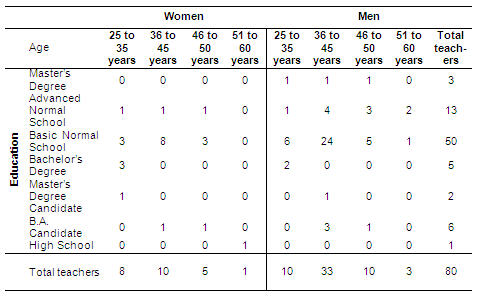
These teachers work in 54 elementary schools distributed over the southern part of the state of Sonora; 48 are public schools, and 6 are private. The schools belong to various socioeconomic levels. The number of teachers working in them is in proportion to socioeconomic distribution of this state: 4 teachers work in schools of high socioeconomic level, 6 teach in upper middle-class schools, 16 in lower middle-class schools, 32 in low-level schools, and 22 teach in schools of a very low socioeconomic level.
The selection procedure for the participants consisted in requesting officials and school supervisors from the various districts to provide a list of 70 sixth-grade, elementary-school teachers working in schools of various socioeconomic levels, such as the 10 Yaqui teachers. The socioeconomic level of the Yaqui schools was classified as very low.
1.2 Instrument
The instrument used to study the conceptions of Planet Earth is an individually-administered, semi-structured interview which uses the following questions and situations, grouped in four thematic blocks:
1. Shape of Planet Earth:
Question 1. With this modeling clay, make what you think is the shape of the Planet Earth. What shape is it?
Question 2. Draw Planet Earth—its shape.
Question 3. What is there around the Planet Earth you have drawn?
2. Location of the Sun and Moon:
Question 4. Where are the Sun and the Moon? Draw them where they are (on the page where you drew the Planet Earth).
3. Where people live on Planet Earth:
Question 5. Do people live all over the surface of the Earth you made with modeling clay? (If the teacher answers “Yes”, go to the questions in Thematic Block 4. If, instead, the teacher is not sure, and/or answers that we do not live on this surface, continue with Questions 5.1 and 5.2).
Question 5.1. Where do the people live?
Question 5.2. Why do we not live all over this surface?
4. The System of reference determined by gravity:
Question 6. Imagine that this doll is from Mexico. Put it where you think it lives on your clay Earth (its orientation). This person is an Eskimo; he lives at the South Pole. Show me how he lives (orientation). This is a penguin that lives at the North Pole; show me how it lives. This is a Chinese person; show how he lives. Why do they live this way, in this position? (Here the intention to get the teacher to justify his/her answer).
Question 7. On your drawing of the Earth, draw the Mexican and the other people in the places and orientations they live in. Why do they live this way, in this orientation? (The intention is to get the teacher to justify his/her answer).
Question 8. Imagine that the Mexican person has a stone in his hand, and he drops it. Draw the trajectory of the stone. Do the same with the Eskimo, the Chinese person and the penguin. Why will the stones go in that direction?
Question 9. Imagine that this glass is half full of water, and that it is beside the Mexican person, at the North Pole, at the South Pole, and in China. Draw how the glass will be, and the level of the water. Why will the water level be the way it is in the glass?
The questions used in the interview combine verbal answers, graphic representation, and three-dimensional expression, using modeling clay. The procedure with which the interview was developed was the Piagetian clinical method of questioning. Based on the responses of participants to each of the interview questions, a free clinical interrogation was conducted, tailored to each teacher, with the aim of understanding his/her conception of this theme.
The material consisted of modeling clay; three dolls, each 2.5 cm. in height; and a 2-cm. toy penguin.
This interview is an adaptation for adults, of the instrument used in Fernandez’s study (2004a), which was constructed based on a review of the interviews used in the work of Nussbaum (1979) and Vosniadou and Brewer (1992). For purposes of this adaptation, we conducted a pilot study with a sample group made up of 10 elementary school teachers working in schools in Ciudad Obregon (Sonora).
1.3 Procedure
The interviews were conducted individually in schoolrooms, within school hours and during the school year 2005-2006. The duration of each was approximately 45 minutes. With the permission of all the teachers, verbal responses were recorded on audio cassettes. The interviews were conducted by two persons with B.S. degrees in Psychology. The teachers’ answers were subsequently transcribed verbatim.
II. Results
To identify the conceptions of Planet Earth, we conducted a qualitative analysis of the answers obtained in each of the interviews’ four thematic blocks: a) shape of Planet Earth; b) location of the Sun and Moon; c) where people live on Planet Earth, and d) geometric system of reference.
This analysis consisted of an inductive process, which organized the data using the overlap between the participants’ answers, which revealed various patterns of response in each of the subjects (see Tables II, III, IV and V). The integration of these response patterns allowed us to identify four conceptions. The criteria which determined the integration of response patterns were based on the results of previous studies (Fernandez, 2004a; Nussbaum and Novak, 1976 and Vosniadou and Brewer, 1992) and scientific explanation of this theme of astronomy. The process of obtaining the various conceptions and the classification of participants was made by consensus among the authors of this study.
Table II. Response patterns in Thematic Block 1:
Shape of Planet Earth, in the various conceptions
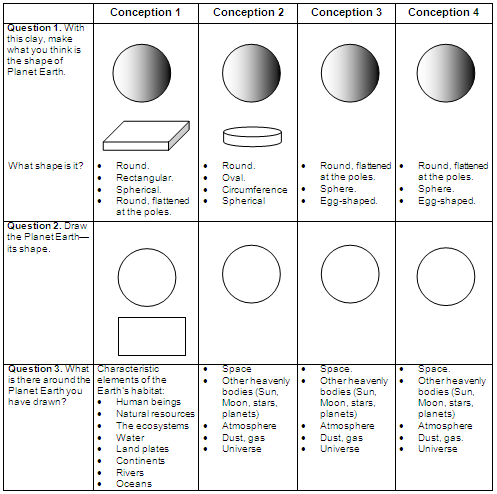
Table III. Response patterns in Thematic Block 2:
Location of the Sun and Moon, in the various conceptions
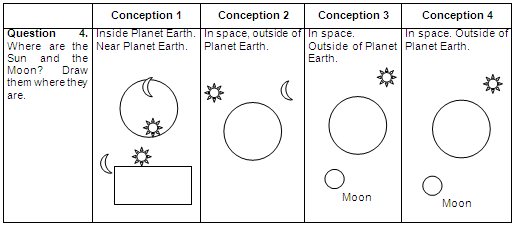
Table IV. Response patterns in Thematic Block 3:
System of geometric reference, in the various conceptions
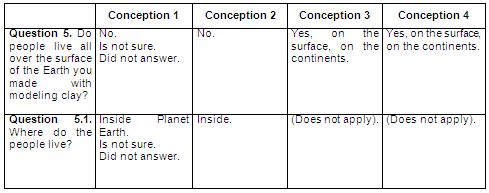
Table V. Response patterns in Thematic Block 4:
Geometric system of reference, in the various conceptions
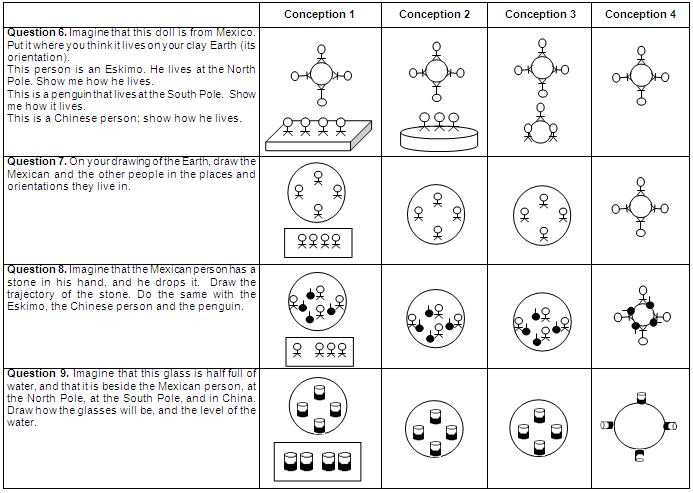
The following is a presentation of the four conceptions of Planet Earth, with examples.
Concept 1. Planet Earth has an indefinite shape. The geometric system of reference is absolute, toward “down”. The teachers classified under this conception model a Planet Earth having a particular shape (spherical, rectangular), but when asked, “What is there around the Planet Earth you have drawn?” they mentioned that there are different features of the Earth’s habitat, such as water, human beings, rocks, continents, and so on. No participant with this conception gave "space" as an answer to this question. An example is the response of a teacher who said that the Earth is “spherical”, and drew a circle to represent this shape. However, when asked, “What is there around the Planet Earth you have drawn?” she said, “Water,” and showed it in her drawing by means of lines around the circle (see Figure 1). Another example is the response of a teacher who believes that the Earth is rectangular, and that around it are water and land plates (see Figure 2).
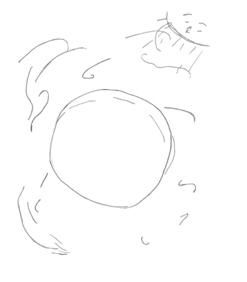
Figure 1. Drawing showing Planet Earth in Conception 1 (47-year-old teacher)
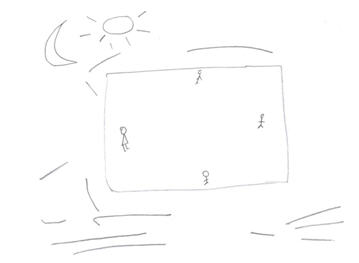
Figure 2. Drawing showing Planet Earth in Conception 1 (42-year-old teacher)
In Question 4 (“Where are the Sun and the Moon?”), some of the participants having this conception answered that the Sun and the Moon are near Planet Earth, For example: “The Sun and the Moon are near; Here is the Earth. The Sun is above the Earth—it would be pretty close to the Earth” (see Figure 3).
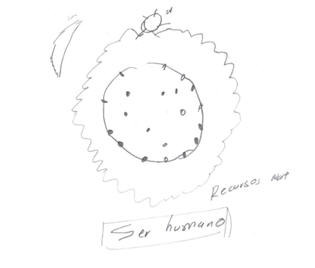
Figure 3. Drawing showing Planet Earth and the location of
the Sun and the Moon in Conception 1 (46-year-old teacher)
Other teachers of this conception believe that the Sun and the Moon are inside Planet Earth (see Figure 4).
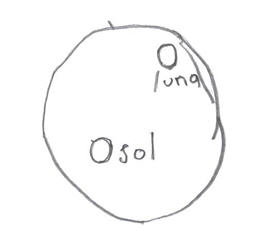
Figure 4. Drawing showing the shape of Planet Earth and the location of the
Sun and Moon in Conception 1 (50-year-old teacher)
In Thematic Block 3 (where people live on Planet Earth), some of the participants believe that we human beings live inside Planet Earth. Others are not sure where the people live, and some teachers did not answer the questions of this section. An example is the response of a teacher who began by answering that we live inside Planet Earth, but in the process of explaining, expressed uncertainty: “Inside… I say inside…say that this is the mass of the Earth…then we all live…all the people live, then…I misunderstood…I thought that it’s the surface, all over, on top…”
The geometric system of reference is understood as an absolute “down” by the participants in this conception classification (see Table V). Some of the teachers place the dolls according to a system related to the center of the modeling-clay Earth (Question 6), but when they have to draw the way the people are oriented in their sketch of Planet Earth (Question 7), they draw them according to an absolute system of reference toward “down” (see Figure 2).
Other teachers of this conception flatten the sphere to show how people live on the Earth. In the situation of the stones that people allow to drop (Question 8) and the water level in the glasses (Question 9), these participants again use a graphic representation of an absolute system of reference toward “down” (see Table V).
Conception 2. Planet Earth has a specific shape (sphere, disk). In the interior of the planet live people oriented in an absolute system of reference toward “down”. The teachers classified as having this conception used the clay to model a specific shape (sphere, disk) for Planet Earth, and drew a circle to represent that shape. Unlike those of Conception 1, these teachers consider that around Planet Earth is the atmosphere, space, and other heavenly bodies, such as the stars, the Moon, galaxies, and the Sun.
In Thematic Block 3 (where people live on Planet Earth), all of the participants classified as having this conception answered that the people live inside Planet Earth. Some teachers cut open the clay ball they had made, and put the dolls inside. An example of this answer is the following:
Interviewer (I): Do the people live all over the surface of the Earth you have made out of clay?
Teacher (T): No.
I: Where do the people live?
T: Can we cut it? [showing the clay ball made to represent Planet Earth].
I: Whatever you think.
T: Here [showing the upper hemisphere of the clay ball] is more than enough space on top. So, for me it would be to cut this…we would cut it like this [cutting the clay ball in half]. I would explain, or any other teacher, we would explain that this part [showing the lower half of the clay ball] would be the mother rock, so then we would put ourselves—the human beings—on top, and this [showing the upper half of the clay ball] we would use to represent space, the air, the clouds and everything that is above us. We are inside a planet that is made up of several factors.
For these teachers, people cannot live on the spherical surface of the Earth, because there is no life there. One teacher explains it in these words: “If we lived all over the surface of the Earth I would say that there is no life. The very particles, positive and negative, would not allow us to live; it is not a 100% adaptable medium for us”.
The understanding of the participants’ system of geometric reference included in this conception is an absolute “down” (see Table V). Some of the teachers place the dolls according to a system of reference relative to the center of the Earth in the situation of the modeling clay, but when, on their drawing of the Earth, they have to draw the way these people are oriented, they draw them according to an absolute system of reference toward “down”. (see Figure 5).
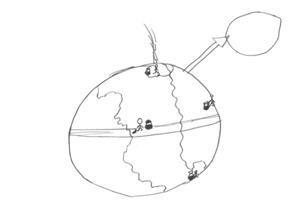
Figure 5. Drawing of Planet Earth and geometric representation of the
reference system in Conception 2 (41-year-old teacher)
Conception 3. Planet Earth has a spherical shape. People live on the surface of the Earth oriented in an absolute system of reference toward “down”. The teachers classified as having this conception made a ball out of the clay, and drew a circle to represent the shape of Planet Earth. Around the Earth are the atmosphere, the universe, space, and other celestial bodies.
Unlike the preceding conception, these teachers considered that people live all over the spherical surface of the Earth, where the continents are found. All the teachers gave an affirmative answer to Question 5 in the interview (“Do people live all over the surface of the Earth?”).
These teachers’ understanding of the geometric reference system is an absolute toward “down”. In Question 6, in which the teachers had to place dolls in different countries of their modeling-clay worlds, the majority oriented them according to a system of reference related to the center of the Earth.
Nevertheless, in the graphical situation (Question 7), where they had to draw the orientation of these persons on Planet Earth, they drew them oriented toward an absolute system of reference toward “down” (see Table V). When they were asked why they drew the people with this orientation, they answered that they could not show in a flat drawing what they did with the clay (a tridimensional situation). An example of this answer is that of a teacher who placed the dolls on the modeling-clay world according to a reference system related to the center of Earth; but when asked why they live with this orientation, answered: “Because of the force of gravity, we don’t feel like we are standing on our heads”. But in the graphic situation, this teacher drew the people according to an absolute system of reference toward “down”. When asked why people live like that, with this orientation, this teacher answered:
“It is flat, a flat sphere. They would not be standing on their heads—they would be in a normal position. We are not really standing on our heads. You can’t make a flat drawing of what I made with the clay”.
This inconsistency between the situation with the clay, and the graphic presented by the teachers having this conception, is due to the difficulty in maintaining a relative system of reference to the center of the Earth, while moving from a tridimensional situation to a bidimensional one, more complex when it came to representing this concept.
The system of reference in the situation of the stones that people drop (Question 8) and the water level in the glass (Question 9), is completely toward “down” (see Figure 6).
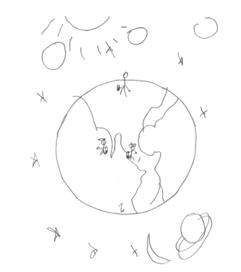
Figure 6. Drawing showing Planet Earth and representation of the
geometric system of reference in Conception 3 (48-year-old teacher)
Conception 4. Planet Earth has a spherical shape. People live on the planet’s surface oriented in a relative system of reference to the center of the Earth. This corresponds to the scientific conception of Planet Earth. The teachers classified as having this conception believe that the Earth is spherical, and that people live all over its surface, where there are continents; the people are oriented in a relative system of reference to the center of the Earth.
Unlike those with Conception 3, all the teachers with this conception present a relative system of reference to the center of the Earth in all situations of Thematic Block 4 (geometric system of reference). They place the characters of different nationalities according to a relative system of reference to the center of the Earth in the situation of the clay, and maintain this orientation in the graphic representation (See Figure7).
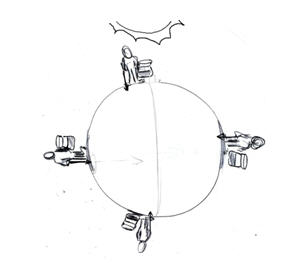
Figure 7. Drawing showing Planet Earth and representation of the geometric
system of reference in Conception 4 (44-year-old teacher)
In the situation of the stones people dropped, and the level of the water in the glasses, the system of reference is relative to the center of the Earth. An example of these responses is presented in the following fragment of an interview:
I: Imagine that the Mexican person is holding a stone, and drops it. Draw the path of the stone.
T: It would go toward the surface, perpendicular to the surface.
I: Do the same with the Eskimo, the Chinese person, and the penguin. How would the path of the stones be? (The teacher draws). Why would the stones go in that direction?
T: Like I just told you, the Earth has this force that attracts objects to its center. If we had here a big hole, it would go on toward the center, always toward the center.
I: Imagine that this glass is half full of water, and it is beside the Mexican person, at the North Pole, at the South Pole, and in China. Draw the way the glasses and the water level in them would be (the teacher draws). Why would the level of the water in the glasses be like that?
T: It’s the same. The high part of the water too, would be perpendicular, or parallel, to the Earth’s surface. In fact, sea level works in relation to the force of gravity, and no part of the ocean is higher than any other part.
Table VI shows the frequency of teachers with the different conceptions of Planet Earth.
Table VI. Frequency of teachers with the conceptions of Planet Earth, according to gender
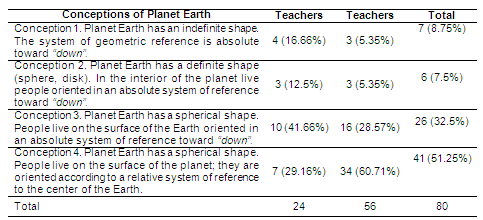
There are significant differences in the distribution of the conceptions according to the gender of the teachers,  (1, N = 80) = 6.692, p < 0.05. A greater frequency of male teachers present scientific conceptions (60.7%) than female teachers (29.1%). There were no significant differences having to do with the teachers’ ages,
(1, N = 80) = 6.692, p < 0.05. A greater frequency of male teachers present scientific conceptions (60.7%) than female teachers (29.1%). There were no significant differences having to do with the teachers’ ages,  (1, N = 80) = .440, p > .05; years of experience,
(1, N = 80) = .440, p > .05; years of experience,  (1, N = 80) = .001, p > .05, and their education,
(1, N = 80) = .001, p > .05, and their education,  (1, N = 80) = 0.359, p > 0.05.
(1, N = 80) = 0.359, p > 0.05.
III. Discussion
The results obtained in this study indicate that almost half of the teachers (49%) presented alternative conceptions of Planet Earth and the system of geometric reference determined by gravity (Conceptions 1, 2 and 3), and that there are significant differences according to gender. A greater frequency of female teachers held alternative conceptions (70.82%) than did male teachers (39.27%).
The present study’s high frequency of teachers with alternative conceptions, in comparison with Vega’s results (2001), in which only 12.5% of a sample of elementary school teachers in Tenerife (Spain) had alternative conceptions, may be due to differences in the instruments used. Studies of methodological comparisons made on this theme (Panagiotaki et al., 2006, Siegal et al., 2004) have verified an increase in the scientific responses of participants when the instrument requires recognition responses, such as multiple-choice questionnaires like the instrument used Vega’s work (2001). In this study, the instrument consisted of an interview composed of open questions that required a product of participants (an explanation, a drawing, a clay model), more complex than recognition responses, but which permit the researcher(s) to obtain more complete and thorough information about the teachers’ understanding of this scientific theme.
Undoubtedly, the element that played the most important role in determining the higher percentage of teachers with alternative conceptions is that in this study the theme of gravity was taken into consideration, along with the way it is linked with the shape of Planet Earth, unlike Vega’s study ( 2001), which took into account only the shape of the Earth. The consideration of this element caused 32.5% of the teachers to be classified under Conception 3 (Planet Earth has a spherical shape, and people are oriented on the surface of this sphere according to an absolute system of reference toward “down”).
However, the results of this study were disappointing, when compared with those obtained by Fernandez (2004a), with similar methodological characteristics and which also took into account the theme of gravity. In that study, children 12 years of age presented the scientific conception with more frequency (60%) than in the present work, where only 51% of elementary-school teachers held this conception.
The gender differences found in this work coincide with the results of numerous studies that indicate a higher success level for men than for women in solving science problems (Cleary, 1991; Beller and Gafni, 1996; Penner, 2003). This difference was explained by cultural gender stereotypes of competencies attributed to the sexes (Smith, White and Sansone, 2007), and differences in certain abilities of biological origin (Baron-Cohen, 2003).
The alternative conceptions of Planet Earth identified in this study show a considerable similarity to those found in previous studies conducted with children. The conception of an indefinite Earth (Conception 1) has been identified in the work of Nussbaum and Novak (1976), Mali and Howe (1979), Nussbaum (1979), Sneider and Pulos (1983), Fernandez (2004a, 2004b). Conception 2, in which teachers believe that within the sphere of Planet Earth live people oriented in an absolute system of reference toward “down”, was identified by Mali and Howe (1979), Nussbaum (1979), and Sneider Pulos (1983), Vosniadou and Brewer (1992), Fernandez (2004a and 2004b). Finally, the idea that people live all over the spherical surface of Planet Earth oriented in an absolute system of reference toward “down” (Conception 3) has also been identified in previous works, with the exception the study by Vosniadou and Brewer (1992) which did not consider the system reference determined by gravity.
These similarities between the alternative conceptions identified in the elementary-school teachers and the work undertaken with children, and the high frequency of teachers with alternative conceptions, indicate that the development process of Planet Earth is neither uniform nor universal. A high percentage of participants, the majority of whom are woman teachers, present prior knowledge based on data of apparent perception (such as Conception 1) or concepts that link data from apparent perception with academic knowledge (Conceptions 2 and 3). These results suggest that coming to an understanding of Planet Earth as spherical, and with a relative system of reference to the center of the Earth, is not as easy as one might expect from a basic knowledge of astronomy.
The results of this study indicate a lack of teacher preparation in the basic themes of science, which lack places a significant restraint on good science education. Several authors have pointed out that teachers’ alternative conceptions may be one of the origins of the prior knowledge which their students present as touching these science themes (Schoon, 1995; Trundle, et al. 2002 Kikas, 2004).
In addition, poor preparation in a discipline has implications regarding the quality of teaching practices. Since these teachers are not aware of their own alternative conceptions about the science themes they should be teaching their students, nor do they realize that they have not experienced conceptual change, they can hardly apply constructivist educational practice, centered in the student and beginning with the student’s prior knowledge and experiences, in their lessons. As a result, these teachers hardly use error as a key element in the construction of knowledge.
The educational implications of the results of this study point to the design and planning of excellent and equitable teacher-training for the area of science education. Educational institutions must take the most appropriate measures to ensure that all elementary-school teachers have a basic education in science, allowing them to be informed, critical, and responsible professionals, able to make individual and collective decisions about scientific and technological problems.
These measures should be directed toward a reform of the training courses offered for elementary-school teachers. In designing such a reform, we must consider that it is not enough to train teachers in the pedagogical tools; they need training also in the science content they must impart to their students. Furthermore, we should take into account the studies which have found that teacher-training courses developed under a constructivist perspective are successful (Camino, 1995; Atwood and Atwood, 1997; Navarrete, 1998; Trumper, 2006; Trundle, et al. 2002). A high percentage of teachers and normal-school students who have taken courses based on a constructivist perspective have been able to modify their alternative conceptions of a variety of scientific themes.
References
Appleton, K. (2003). How do beginning primary school teachers cope with science? Toward an understanding of science teaching practice. Research in Science Education, 33, 1-25.
Atwood, R. K. (1995). Preservice elementary teachers’ conceptions of what causes night and day. School Science and Mathematics, 95 (6), 290-294.
Atwood, R. K. & Atwood, V. A. (1997). Effects of instruction on preservice elementary teachers’ conceptions of the causes of nigtht and day and the seasons. Journal of Science Teacher Education, 8 (1), 1-13.
Baron-Cohen, S. (2003). The essential difference: The truth about the male and female brain. NY: Basic Books.
Beller, M. & Gafni, N. (1996). The 1991 international assessment of educational progress in mathematics and sciences: The gender differences perspective. Journal of Educational Psychology, 88 (3), 365-377.
Camino, N. (1995). Ideas previas y cambio conceptual en astronomía. Un estudio con maestros de primaria sobre el día y la noche, las estaciones y las fases de la luna. Enseñanza de las Ciencias, 13, 81-96.
Cleary, A. (1991). Gender differences in aptitude and achievement test scores. Educational Testing Service, Sex equity in educational opportunity, achievement, and testing: Proceedings of the 1991 ETS Invitational Conference (pp. 51-90). Princeton, NJ: Educational Testing Service.
De Manuel, J. (1995). ¿Por qué hay veranos e inviernos? Representaciones de estudiantes (12-18) y de futuros maestros sobre algunos aspectos del modelo Sol-Tierra. Enseñanza de las Ciencias, 13 (2), 227-236.
Fernández, T. (2004a). Concepciones del planeta Tierra. Capacidades espaciales implicadas. Infancia y Aprendizaje, 27 (2), 189-210.
Fernández, T. (2004b). Concepciones del planeta Tierra en indígenas karajás de Brasil. Revista Latina de Pensamiento y Lenguaje, 12 (2), 161-182.
Kikas, E. (2004). Teachers’ conceptions and misconceptions concerning three natural phenomena. Journal of Research in Science Teaching, 41 (5), 432-448.
Mali, G & Howe, A. (1979). Development of earth and gravity concepts among nepali children. Science Education, 63 (5), 685-691.
Navarrete, A. (1998). Una experiencia de aprendizaje sobre los movimientos del sistema Sol/Tierra/Luna en el contexto de la formación de maestros. Investigación en la Escuela. Revista de Investigación e Innovación escolar, 35, 5-20.
Nussbaum, J. (1979). Children’s conception of the earth as a cosmic body: A cross-age study. Science Education, 63 (1), 83-93.
Nussbaum, J. & Novak, J. (1976). An assessment of children’s concepts of the earth utilizing structured interviews. Science Education, 60 (4), 535-550.
Organisation for Economic Co-operation and Development (2000). Measuring student knowledge and skills: The PISA assessment of reading, mathematical and scientific literacy. Paris: Author.
Panagiotaki, G., Nobes, G. & Banerjee, R. (2006). Children’s representations of the earth: A methodological comparison. British Journal of Developmental Psychology, 24 (2), 353-372.
Parker, J. & Heywood, D. (1998). The earth and beyond: Developing primary teachers’ understanding of basic astronomical events. International Journal of Science Education, 20 (5), 503-520.
Penner, A. (2003). International gender x item difficulty interactions in mathematics and science achievement tests. Journal of Educational Psychology, 95 (3), 650-655.
Samarapungavan, A., Vosniadou, S. & Brewer, W. (1996). Mental models of the earth, sun, and moon: Indian children’s cosmologies. Cognitive Development, 11 (4), 491-521.
Schoon, K. J. (1995). The origin and extent of alternative conceptions in the earth and space sciences: A survey of pre-service elementary teachers. Journal of Elementary Science Education, 7 (2), 27-46.
Siegal, M., Butterworth, G. & Newcombe, P. (2004). Culture and children’s cosmology. Developmental Science, 7 (3), 308-324.
Smith, J., Sansone, C. y White, P. (2007). The stereotyped task engagement process: The role of interest and achievement motivation. Journal of Educational Psychology, 99 (1), 99-114.
Sneider, C. & Pulos, S. (1983). Children’s cosmographies: Understanding the earth’s shape and gravity. Science Education, 67, 205-221.
Trumper, R. (2003). The need for change in elementary school teacher training – A cross-college age study of future teachers’ conceptions of basic astronomy concepts. Teaching & Teacher Education, 19 (3), 309-323.
Trumper, R. (2006). Teaching future teachers basic astronomy concepts–seasonal changes–at a time of reform in science education. Journal of Research in Science Teaching, 43 (9), 879-906.
Trundle, K. C., Atwood, R. K. & Christopher, J. E. (2002). Preservice elementary teachers’conceptions of moon phases before and after instruction. Journal of Research in Science Teaching, 39 (7), 633-658.
Vega, A. (2001). Tenerife tiene seguro de Sol (y de Luna): Representaciones del profesorado de primaria acerca del día y la noche. Enseñanza de las Ciencias, 19 (1), 31-44.
Vosniadou, S. & Brewer, W. (1992). Mental models of the earth: A study of conceptual change in childhood. Cognitive Psychology, 24 (4), 535-585.
Translator: Lessie Evona York Weatherman
UABC Mexicali
1The present work has been possible thanks to the financing provided by the combined funds, CONACYT-Government of the State of Sonora (SON-2004-C02-007) and the indispensable collaboration of the participating teachers.
2The Yaquis are an ethnic group belonging to the Yute-Aztec family, the Pima group and the Opata Cahita Tarahumara subgroup. The are located in the southeast region of the Mexican state
of Sonora.
Please cite the source as:
Fernández Nistal, M. T. & Peña, S. H. (2008). Elementary School Teachers’ Conceptions of Planet Earth and of Gravity. Implications for Science Education. Revista Electrónica de Investigación Educativa, 10 (2). Retrieved month day, year, from: http://redie.uabc.mx/vol10no2/contents-fernandeznistal.html












